
| WWT Shows | CLICK TO: Join and Support Internet Horology Club 185™ | IHC185™ Forums |

|
• Check Out Our... • • TWO Book Offer! • |
Welcome Aboard IHC185™  Internet Horology Club 185
Internet Horology Club 185  IHC185™ Discussion Site Main Page
IHC185™ Discussion Site Main Page  Horological Discussions, Questions and Answers
Horological Discussions, Questions and Answers  All Wristwatches Discussion Forum
All Wristwatches Discussion Forum  Difference Between Hamilton Seneca & Sherwood?
Difference Between Hamilton Seneca & Sherwood?
 Internet Horology Club 185
Internet Horology Club 185  IHC185™ Discussion Site Main Page
IHC185™ Discussion Site Main Page  Horological Discussions, Questions and Answers
Horological Discussions, Questions and Answers  All Wristwatches Discussion Forum
All Wristwatches Discussion Forum  Difference Between Hamilton Seneca & Sherwood?
Difference Between Hamilton Seneca & Sherwood?Go  | New Topic  | Find-Or-Search  | Notify  | Tools  | Reply to Post  |  |
I am posting two pictures of Senca and Sherwood. There is a difference in cases. One looks flater. Also the lines right above the top and bottom of cases looks different. One looks curved and the other flatter. One case says 14k gold and the other says 14k solid gold. Is there a difference between these watches? On a reputable site it mentions that it was just a name change. Advice appreciated, thanks. Not asking for value, but is there a difference in value between the two? Is one worth more than the other? 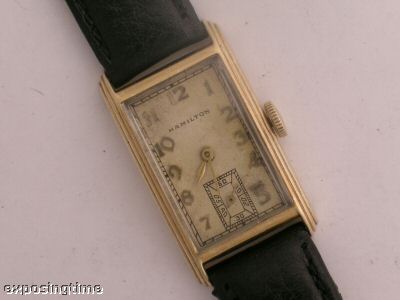 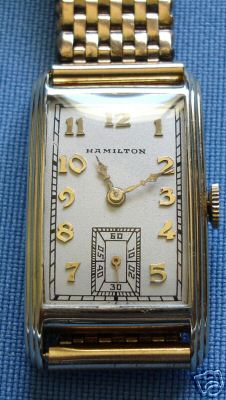 | |||
|
| Hamilton WW Expert IHC Life Member |
Hi Popeye: The Seneca was the first of the 982 series introduced and was without question, one of Hamilton’s most successful offerings (Seneca production ran from 1935 to 1940). It was introduced on April 1st 1935 and its “low dial numbers” further indicate early introduction – dial “D1,” was inlaid enamel and dial “D2,” was applied gold numerals. The model was originally introduced as the Seneca and as Don mentions in the preceding post, a letter was sent to wholesalers on January 22nd 1936 announcing the name change saying that the “change applies only to the name of the case style – price, case and dial remain the same.” However this may not necessarily be the case (no pun intended), as Hamilton records, although very precise, have been wrong before. For clarification purposes, when you mention the case markings, are you referring to the “W14K Solid Gold” stamped on the outside of the back case or are you referring to the stampings on the inside of the back case? Of the four examples that I own, there does not appear to be any case variations as I have measured each example very carefully. But than again, I may not have the “variation” example to make a suitable comparative analysis. A case variation would not be unusual as there are many case variations amongst Hamilton models and if there is a difference, it would likely be very slight and I doubt it would be significant enough to qualify one being valued over the other. There are however, variations of case markings stamped inside the rear back case – two of my Seneca’s are marked “Hamilton Watch Company” and one is not. The two that are marked "Hamilton" are also marked “14K solid gold.” The one that bears no “Hamilton” indication is marked “14K gold” only. My fourth example is a “Howard/Seneca” example and therefore would be unfair to use as a comparison (see Hamilton Seneca/Howard). If you could clarify which case stampings you are referring to (outside back, or inside back) along with each example serial number (movement and case) and the correct measurements in millimeters, I would greatly appreciate it. Maybe then we could get to the bottom of this question. Kindest regards, Will PS – I prefer to refer to the Seneca/Sherwood as the “Seneca” as Hamilton used the model name “Sherwood” for their “wood dialed” models during the 1950’s. Using the name “Seneca” leaves no questions as to which model you are referring to. | |||
|
Here the pics of back of case. First said was a Sherwood. 2nd that says solid is Seneca. The one that says solid gold. What does serial number mean as far as date or anything else? The serial on the solid gold inside marking movement says J2320-any significance with that number? Lastly, is the whiter dial redone? The darker one original? Info appreciated! Thanks for replying. 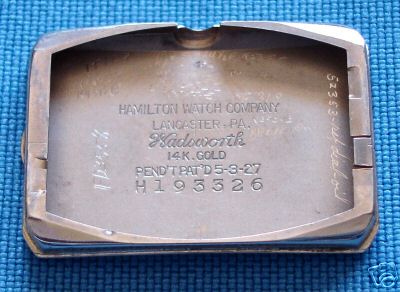 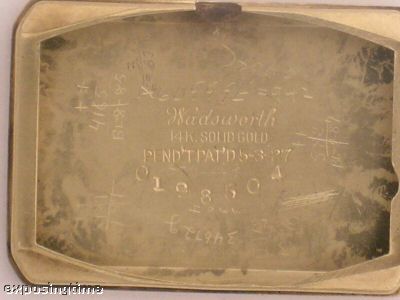 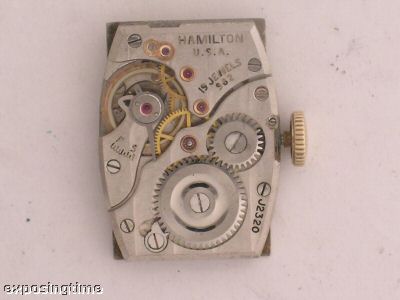 | ||||
|
| IHC Member 376 Watchmaker |
Nice Watches Mark | |||
|
Thanks. | ||||
|
| Hamilton WW Expert IHC Life Member |
Mark: Firstly, both examples are Seneca’s and both examples are Sherwood’s – there is no styling differences that can be attributed to either name. Hamilton simply changed the name of the watch just as they did with the Floyd Bennett / Captain Rice in 1930 and the Bartlett / Barkley in 1935. Little can be told from the case serial number unless there is a distinct case difference and even then, there is no guarantee that the case numbers will run consecutively. Serial numbers run in “fits and starts.” In some cases, Hamilton may have had the case manufacture run a number of cases off and than not make another “run” until months later. Therefore, there can be a significant gap in numbers as the case manufacture may have used the consecutive numbers for a completely different model and for a completely different watch company. And in some cases, Hamilton even used different case manufactures to make the same model i.e. the Langley of 1929, made by both S&W and Solidarity (certainly there are no consecutive numbers there). When dating a watch, it is best to use the movement (providing the movement is not a replacement). Your 982 movement serial number (J2320) is likely correct and dates your watch to early 1935, making it an early issue Seneca (or Sherwood – whichever name you prefer). But even then, dating a watch can be precarious – there are instances where Hamilton utilized inventoried movements in cases that are significantly newer than the movements that ran them. The lesson here is that you can never truly be “positive” about anything – you can merely hypothesize. There are however “Hamilton collectors” that have a “nose” for what’s right and what wrong (Bryan and Rene are two such people). But that comes from experience in seeing numerous examples in person. Regarding your dial, that’s a hard call without seeing it in person. Although your white dial appears to be refinished and your darker dial appears to be original, you really have to examine them to be sure. One way to tell is to examine the dial and see if the patina is consistent under the bezel. Another is to look at the back of the dial and see if there are any “refinisher” marks i.e., numbers that refinishers scratch in the back and or marks indicting the top of the dial. I have a Seneca with a pristine dial – so nice in fact, you would swear it was refinished. But alas, it was not (I’ll be posting some pictures of it when I have the time as the watch belonged to baseball legend Joe DiMaggio and was one of his favorite watches - but that’s another story). I hope I have been helpful. Regards, Will | |||
|
It was VERY helpful, thank you. That is exciting, Joe D's watch. That is priceless, does it have his name on the back? Thanks for the response. | ||||
|
| Hamilton WW Expert IHC Life Member |
Hi Mark: Yes it does have his name engraved on the back of the watch. It was presented to him in 1937 and he kept it his entire life. His family said it was one of his favorite watches and I have pictures of him wearing it as well. It's a Hamilton Seneca and I'll be taking some pictures of it and post the story behind the watch shortly. Regards, Will | |||
|
| Powered by Social Strata |
| Your request is being processed... |
|
Welcome Aboard IHC185™  Internet Horology Club 185
Internet Horology Club 185  IHC185™ Discussion Site Main Page
IHC185™ Discussion Site Main Page  Horological Discussions, Questions and Answers
Horological Discussions, Questions and Answers  All Wristwatches Discussion Forum
All Wristwatches Discussion Forum  Difference Between Hamilton Seneca & Sherwood?
Difference Between Hamilton Seneca & Sherwood?
 Internet Horology Club 185
Internet Horology Club 185  IHC185™ Discussion Site Main Page
IHC185™ Discussion Site Main Page  Horological Discussions, Questions and Answers
Horological Discussions, Questions and Answers  All Wristwatches Discussion Forum
All Wristwatches Discussion Forum  Difference Between Hamilton Seneca & Sherwood?
Difference Between Hamilton Seneca & Sherwood?©2002-2025 Internet Horology Club 185™ - Lindell V. Riddle President - All Rights Reserved Worldwide

